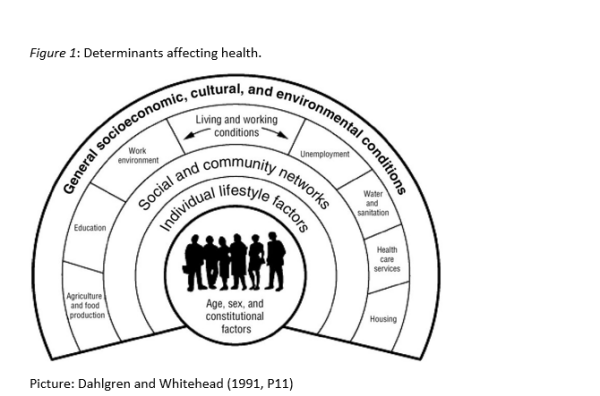
Studerandebloggen/ Student blog
Culture as a determinant of health

Abstract
Culture is a foundational determinant of health. Culture affects people and their health behaviours. This paper will focus on how health behaviour and health communication and thus how health is affected by culture. The effect of culture on health behavior is indirect and direct. Culture affects how people think about sickness and healthiness, how they eat, how they take care of them self and others. This paper concludes that understanding culture is therefore important for healthcare professionals in order to effectively conduct health communication interventions and to communicate in a more culturally competent way when meeting clients and patients in a society where cultures interact increasingly with each other.
Authors:
Blandine Mirindi
BSc student nurse
Novia UAS
Anita Wikberg
Supervisor, RN, RM, PhD, Senior lecturer
Novia UAS
Introduction
The health of an individual is determined by many different factors such as socio-economic, environmental, and cultural factors (Dahlgren and Whitehead 1991). One definition of culture is “the way of life, especially the general customs and beliefs, of a particular group of people at a particular time” (Cambridge dictionary, n.d.). Culture is a factor that can affect the health of an individual directly and indirectly. Understanding how culture affects health and health behaviour can be seen as something important, especially for healthcare professionals, in a society where different cultures interact increasingly with each other.
The term ´cultural competence' is something that has been increasingly in use in the context of health care. Cultural competence means that one is able “to understand, appreciate, and interact with persons from cultures and/or belief systems other than one’s own, based on various factors” (Segen's Medical Dictionary, 2011). One can conclude based on this definition that it is crucial to understand how culture can affect health to be a culturally competent health care professional. This paper will focus on how health behaviour and health communication and thus how health is affected by culture.
Culture and health behaviour
It is widely accepted that culture is something that affects people’s health by affecting health behaviour. As mentioned earlier culture can affect health and health behaviour indirectly and directly. For example, a culture can have dietary customs that can directly affect health negatively. This is an example of a direct effect. Some cultures can value collectivism more than others and thus affect a person’s health by taking care of other people at the expense of his/her own health. (Kreuter & McClure, 2004).
Culture affects the way people see healthiness and sickness. For example, the idea that mothers and wives have about sickness affects how they take care of their relatives, since in many cultures’ women are the ones who take care of ill relatives. Gender roles in different cultures can affect health behaviour also in other ways. In some cultures where women are not treated equally, there might be less information regarding health available for women. (Schiavo, 2013). Gender and how gender roles are affected by which culture someone belongs to. Culture is therefore an important aspect to think about when meeting patients and clients from cultures where gender roles differ.
Cultural determinants of health behaviour are many. Culture can affect the diet, work-life, how one takes care of oneself and how easily one seeks for help of health care professionals as well as receptibility to health messages. For example, the use of alcohol and tobacco is to some extent governed by how the culturally acceptable alcohol and tobacco use is. (Chaturvedi, Arora, Dasgupta, & Patwari, 2011)
In the context of culture and health behaviour, fatalism is a concept that has been widely studied. Fatalism is seen as a cultural determinant of health behaviour and can be defined as the belief that some things that happen in one’s life are inevitable and cannot be prevented. (Flynn, Betancourt, & Ormseth, 2011). Flynn et al. (2011), Investigated how culture in the form of fatalism affected health behaviour as to their compliance to breast exams of Latino and Anglo women in the US. The study found that fatalism does indeed affect health behaviour. The authors further recommend screening fatalism to enhance breast cancer screening. Culture, as previously mentioned does therefore affect how people seek help from health care professionals.
Even though culture is something that can affect health, it is not the only thing affecting health. It is obvious and important to note that even within culture groups, large variations can occur since culture interacts with for example, socio-economic status, individual education level and social networks of an individual. Culture is therefore only one complex factor that cannot be generalized to a whole ethnic group. Culture is described as one structural/foundational health determinant along with socio-economic and environmental conditions by Dahlgren and Whitehead (1991). Health determinants as described by Dahlgren and Whitehead (1991) can be seen in figure 1 below.

Culture and health communication
We have now discussed how culture affects health behaviour and health. Understanding how culture affects health behaviour is obviously important to be able to be culturally competent. Cultural competence is arguably an important proficiency for health care professionals when communicating with clients and patients.
There are many different aspects that should be considered when planning or conducting health communication interventions. Firstly, the idea of healthiness and sickness of a certain culture is something that needs to be known by health care professionals when conducting health communication interventions in order to effectively reach out to different target groups. (Schiavo, 2013).
The content of the message when communicating health is important, but the delivery of the message is also important. Cultural competence includes understanding the need of adapting language and message delivery style to specific groups. This is called audience segmentation and means that the population is divided into smaller groups that share for example, a culture. Audience segmentation is important in order to specifically target the message content and message delivery style in order to effectively reach wanted health communication outcomes (Schiavo, 2013). The type of message in health communication should vary from one target audience to another. Different types of messages in health communication are for example fear messages, use of narrative versus statistical language, comparing gain versus loss of a specific health behaviour. Choosing the type of message is important and should be adapted to a specific target audience in order to enhance how well the message is received and how well the information in the message is implemented by the target audience. (Kreuter & McClure, 2004)
Conclusion
This paper has focused on culture as a determinant of health and how culture should be considered in health communication and when working in intercultural settings. Even though culture is a foundational determinant affecting health it is only one determinant of many affecting health and health behaviour. Understanding culture and how it affects health behaviours is important for health care professionals to effectively communicate in intercultural settings and to be culturally competent. Even though understanding culture is important it is important to understand that culture interacts with other determinants, for example, with gender as well as socio-economic and environmental factors. Culture should naturally be considered when planning for health communication interventions. Recognizing target audiences by audience segmentation, adapting the message for a specific target audience and for example recognizing the idea of sickness within a cultural group are all important aspects in health communication. These are all aspects that could be seen as important competencies for individual health care professionals in their daily work life meeting patients and clients from other cultures.
References
- Chaturvedi, S., Arora, N. K., Dasgupta, R., & Patwari, A. K. (2011). Are we reluctant to talk about cultural determinants? The Indian Journal of Medical Research, 133(4), 361. Accessed 7.10.2020
- Segen's Medical dictionary. (n.d.) Cultural competence. (2011). Retrieved October 20.10.2020 from https://medical-dictionary.thefreedictionary.com/cultural+competence
- Cambridge Dictionay. (n.d.) Culture. (n.d.). Retrieved October 20.10.2020 from https://dictionary.cambridge.org/dictionary/english/culture
- Dahlgren G, Whitehead M. 1991. Policies and Strategies to Promote Social Equity in Health. Stockholm, Sweden: Institute for Futures Studies. Accessed 10.10.2020
- Flynn, P. M., Betancourt, H., & Ormseth, S. R. (2011). Culture, emotion, and cancer screening: an integrative framework for investigating health behavior. Annals of Behavioral Medicine, 42(1), 79-90. Accessed 7.10.2020
- Kreuter, M. W., & McClure, S. M. (2004). The role of culture in health communication. Annual review of public health, 25, 439–455.
- https://doi.org/10.1146/annurev.publhealth.25.101802.123000 Accessed 14.10.202
- Schiavo, R. (2013). Health communication: From theory to practice (Vol. 217). John Wiley & Sons. Accessed 7.10.2020
Studerandebloggen
Ansvarsfriskrivning: Författaren/författarna ansvarar för för fakta, möjlig utebliven information och innehållets korrekthet i bloggen. Texterna har genomgått en granskning, men de åsikter som uttrycks är författarens egna och återspeglar inte nödvändigtvis Yrkeshögskolan Novias ståndpunkter.
Disclaimer: The author(s) are responsible for the facts, any possible omissions, and the accuracy of the content in the blog.The texts have undergone a review, however, the opinions expressed are those of the author and do not necessarily reflect the views of Novia University of Applied Sciences.